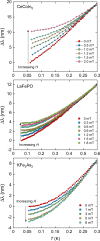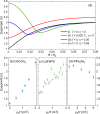Observation of the non-linear Meissner effect
- PMID: 35256611
- PMCID: PMC8901765
- DOI: 10.1038/s41467-022-28790-y
Observation of the non-linear Meissner effect
Abstract
A long-standing theoretical prediction is that in clean, nodal unconventional superconductors the magnetic penetration depth λ, at zero temperature, varies linearly with magnetic field. This non-linear Meissner effect is an equally important manifestation of the nodal state as the well studied linear-in-T dependence of λ, but has never been convincingly experimentally observed. Here we present measurements of the nodal superconductors CeCoIn5 and LaFePO which clearly show this non-linear Meissner effect. We further show how the effect of a small dc magnetic field on λ(T) can be used to distinguish gap nodes from non-nodal deep gap minima. Our measurements of KFe2As2 suggest that this material has such a non-nodal state.
© 2022. The Author(s).
Conflict of interest statement
The authors declare no competing interests.
Figures





References
-
- Hirschfeld P, Korshunov M, Mazin I. Gap symmetry and structure of Fe-based superconductors. Rep. Prog. Phys. 2011;74:124508.
-
- Prozorov R, Giannetta RW. Magnetic penetration depth in unconventional superconductors. Supercond. Sci. Tech. 2006;19:R41.
-
- Carrington A. Studies of the gap structure of iron-based superconductors using magnetic penetration depth. Comptes Rendus Phys. 2011;12:502.
-
- Yip SK, Sauls JA. Nonlinear Meissner effect in CuO Superconductors. Phys. Rev. Lett. 1992;69:2264. - PubMed
-
- Carrington A, Giannetta RW, Kim JT, Giapintzakis J. Absence of nonlinear Meissner effect in YBa2 Cu3 O6.95. Phys. Rev. B. 1999;59:R14173.
Grants and funding
LinkOut - more resources
Full Text Sources
Research Materials
Miscellaneous

